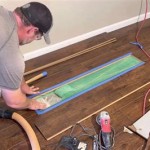Vinyl Plank Flooring over Concrete Expansion Joint Filler: A Comprehensive Guide
Vinyl plank flooring has become increasingly popular due to its durability, affordability, and ease of installation. However, when installing vinyl plank flooring over concrete, special attention must be given to the expansion joint filler. Expansion joints are gaps left between sections of flooring to accommodate expansion and contraction caused by temperature and moisture changes. Proper filling of these joints is crucial to prevent buckling, warping, and other issues.
Here are some essential aspects to consider when selecting and using expansion joint filler for vinyl plank flooring over concrete:
Material Composition
Expansion joint fillers are typically made from cork, foam, or rubber. Cork is a natural material that provides excellent sound absorption and insulation, while foam is a lightweight and inexpensive option. Rubber is the most durable and moisture-resistant material, making it ideal for areas where spills and moisture are common.
Joint Width
The width of the expansion joint will depend on the size and type of vinyl plank flooring being installed. Manufacturers typically recommend a gap of 1/4 to 3/8 inch for each 10 feet of flooring length. It's important to consult the manufacturer's guidelines to determine the appropriate joint width for your specific flooring.
Installation Technique
Expansion joint filler should be installed before laying down the vinyl plank flooring. Clean and dry the concrete surface thoroughly, then apply a thin layer of adhesive to the back of the expansion joint filler. Press the filler firmly into place along the edges of the concrete subfloor, ensuring that it is flush with the top surface.
Moisture Resistance
In areas where moisture is a concern, such as bathrooms, kitchens, or basements, it's essential to use a moisture-resistant expansion joint filler. Rubber is the preferred material for these areas, as it can withstand water and prevent the growth of mold and mildew.
Compressibility
Expansion joint filler should be compressible to accommodate expansion and contraction of the flooring. Choose a filler that has enough give to allow the flooring to move without creating any buckling or warping.
Durability
The expansion joint filler should be durable enough to withstand foot traffic and everyday wear and tear. Higher-quality fillers will last longer and provide better protection for your flooring investment.
By following these guidelines, you can ensure that the expansion joints in your vinyl plank flooring are properly filled, protecting your floor from damage and ensuring its longevity.

Concrete Expansion Joints And Resilient Flooring Elite Publishing

Easy Ways To Install Vinyl Plank Flooring On Concrete

50mm Width Aluminum Floor Expansion Joint Cover For Concrete Slabs

How To Install Vinyl Flooring On Concrete Floor Ers

Concrete Joint Filler By Protective Polymers

Lock Metal Concrete Floor Expansion Joint Covers For Big Buildings

Versaflex Joint Fill Advisory

Jointex Pu

Is An Expansion Joint Necessary For Vinyl

Joint Filling Commercial Construction Zander Solutions
See Also







